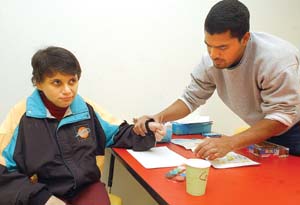
They are often forgotten by society.
Many of them fall in between the black and white and become
lodged in the hazy gray area of existence.
They are often forgotten by society.
Many of them fall in between the black and white and become lodged in the hazy gray area of existence.
Options for the developmentally disabled can be limited. A new organization in Hollister, Social Vocational Services (SVS), is working to broaden the alternatives for the disabled population, while facilitating opportunity and growth for them in the community.
“We’ve always been very interested in having our clients out in the community,” said Regional Director Russ Bower. “And not in a segregated or sheltered setting.”
SVS is a California nonprofit organization that was incorporated in 1978 in Southern California. It now services communities from Orange County to the Bay Area, with 11 regional offices throughout the state, Bower said.
SVS programs serve a wide range of developmentally disabled adults – from those who can earn minimum wage in the workforce with minimal support, to those who are completely nonverbal and require constant supervision.
Abetting their clients in gaining experience and training in the social skills necessary for independent work and community integration, behavioral control, and basic day-to-day activities – such as cooking meals and doing laundry – constitute some of the organization’s services.
“This facility will house folks and we’ll do programming here, but we have our own vehicles and we do programming out in the community as well,” Bower said. “We’ll work on purchasing skills, like going to a restaurant, so they can avail themselves of the community amenities.”
The site, located in downtown Hollister, opened its doors March 1 and currently has four clients with referrals for seven more. The clients, who live in Hollister, Gilroy and Morgan Hill, are picked up by an SVS van between 7 and 8:30 a.m. every weekday morning, and stay at the facility until between 2 and 2:30 p.m.
Every week, a program coordinator confers with each client and composes a schedule according to their individual needs, objectives and skill acquisition. Encouraging the clients to assist in developing their own schedules is one of SVS’s central goals, Bower said.
“We want to be able to get as many folks who need our services to be able to avail themselves of it here. We’re pretty flexible,” he said. “Where some programs have to be 100-percent work, we have the luxury of being able to work part of the time and do other social skills and training.”
The organization acclimates its employees to a wide variety of issues relating to the disabled population.
Through an extensive orientation program, they are trained to be proficient in educational, behavioral, developmental and work skills relating to the clients.
“We prefer folks that have experience, but occasionally we have somebody that applies that has the right kind of mindset and interest in working with this population,” he said.
Though there isn’t an immediate need for volunteers, they occasionally utilize community members’ services depending on their needs at a given time.
While SVS works closely with group homes, the clients they are currently serving all live with their natural parents.
With the closing of the San Jose Agnews Developmental Center in 2005, Bower expects some of the clients who previously resided there to be relocated in the surrounding areas, and subsequently in possible need of their services.
Bringing a new business into the community, which will help the economy to some extent, and introducing their clients into the general populace are all positives for the city, Bower said.
“I think it’s important for Hollister in the fact that it’s going to afford them a glimpse into our clients,” he said. “One conscious decision we made in purchasing this building is that it’s right in the middle of town. We’ll be taking our folks on walks. Hopefully, they will become well integrated into the community.”
The decision to move into Hollister was made several years ago, however, various setbacks stretched out the actual inception. The facility is licensed to hold 60 clients, and once they get on a solid footing they will be looking at even more options for their patrons.
Supported living services, in which a client lives in his or her own apartment and is supervised either full or part time by a staff member, could be integrated into Hollister’s program in the future if there is an interest, Bower said.
“It’s just options,” he said. “Traditionally communities may have one or maybe two options for folks. That’s one main goal – to proliferate growth and bring a little bit different slant on services.”
After more than 20 years in the industry, Bower has seen tremendous changes in the way the disabled population is treated.
SVS’s longevity and expansion, both physically and ideologically, has been a great catalyst in producing a higher standard in regard to disabled individuals, and a better understanding for the rest of society, he said.
“That’s really what it’s all about,” he said. “Expose people to as much of the world as we can, and the other side of that, expose the world to us and strengthen the fabric of the community.”









